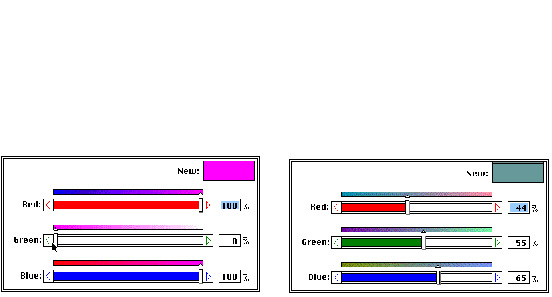|
|

|
|

Different inks may produce slightly different colors. Acme's magenta ink may not be exactly like Widget's magenta ink. And the cyan ink from Wonderful Supply company may produce a more greenish color than the cyan ink from Wow'em Arts which seem a little more bluish. The green phosphors on an Apple monitor may be a little brighter than the green phosphors on a Radius display. The red phosphors on a Sony Trinitron picture tube may be a little different than the red phosphors on a Magnavox picture tube. There are adjustments that let you adjust the color on your television to suit your own tastes. Likewise adjustments on printing processes let a printer take into account variations in ink or printing presses or desktop printers.
Cyan, yellow, and magenta? Have you heard those colors before, cyan and magenta? You may not have. In grade school art class you may have talked about the primary colors as blue, yellow, and red. You can use those to mix colors very well, just as inks from different companies, with different color characteristics, can still be used in printing a full, four-color picture. However, your art teacher was probably thinking of cyan and calling it blue and thinking of magenta and calling it red just to make art and color mixing seem a little easier.
In specifying exactly what some color is to be, you could specify the amount of red, green, and blue light that it should contain. Some color controls on desktop computers let you pick a color that way. Some examples are shown in Figure 17.31.

More often, however, colors are specified in terms of hue, saturation, and lightness (h, s, l); or these may be called hue, saturation, and brightness (h, s, b). Adjustments to your color television use this method. Some color controls on desktop computers also let you choose colors using this technique or process or terminology. Hue refers to the basic color; are we talking about a red or an orange or a red-orange? In terms of Figure 17.32, hue give the angular location on the color wheel there. You may think of saturation describing how much pigment you have added to white paint. With a high saturation, we have lots of red pigment to make a brilliant crimson red. With little saturation we have only a little red pigment to make a soft pink. Lightness describes how light or bright the whole color is. Even brilliant crimson red will look dark and rusty when illuminated by a candle in an otherwise dark room. Some additional examples are shown in Figure 17.33.


A: A red filter absorbs green and blue from the white light, leaving only red. A magenta filter absorbs only green and there is no green in the light by the time it reaches the magenta filter so this filter has no effect on it and the red light passes through unaffected.
A: A red filter absorbs green and blue from the white light, leaving only red. A yellow filter absorbs blue light and lets red (and green) light pass through. Therefore, red light emerges from both filters.

|
|